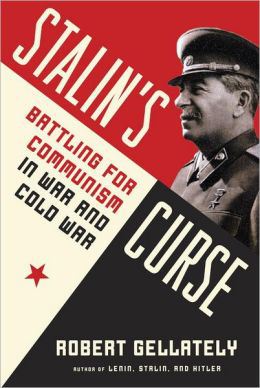There’s a lesson here for those who imagine one-party states, ideologues, and power-hungry tyrants are not really so different from you and me.
Lenin's Good Servant
This impressive book is not well served by its title. It is not clear what the author means by “Stalin’s curse?” Is it his personality, or his politics? Is it his attempts to promote communism, or the unintended consequences of these efforts? Is this a study of the connections between Stalin’s personality and his policies, or a history of the Soviet Union with special reference to Stalin? It seems to be both with Stalin often receding from the narrative.
For those specializing in the critical study of the Soviet system there are few major revelations here but much of what we already know is resoundingly confirmed and clarified. This is a meticulously researched and well written study that makes extensive use of archival and other primary sources. In addition to the large amount of eye-opening information assembled the strength of the book is bolstered by a bracing critical approach. The author does not mince words and does not shrink from expressing his justifiably negative views of Stalin and the “Soviet experiment” unlike many academic intellectuals who do not wish to appear “judgmental” in such matters.
Aside from the rewarding chronological-factual survey and analysis of Soviet history and foreign policy I found three themes of the book particularly noteworthy and useful. First, the emphasis on the ideological determination of Stalin’s policies – often neglected, deemphasized, or outright denied by many academic specialists. Second, the questioning and demolition of the “revisionist” views of the Cold War and thirdly the light shed on the interaction among Stalin, Churchill, Roosevelt and Truman and especially their assessments and misperceptions of Stalin.
Positions taken about the ideological roots of Stalin’s policies have always reflected and paralleled corresponding views of the part played by ideology in the shaping of the Soviet system as a whole and of various specific Soviet policies, domestic and foreign. More often than not Stalin has been seen – by academic authors, public opinion-makers and the educated public at large – not as an ideologue, or aspiring philosopher-king but a crude, amoral brute whose thirst for power was insatiable and whose ruthless policies were single-mindedly guided by the pursuit and maximization of his personal power. By contrast, as Gellately writes:
…the ‘traditionalist’ focus on international power politics misrepresents Stalin’s ambitions… Marxist-Leninist teachings informed everything in his life… He saw himself as anything but an updated version of an old-style Russian tsar… in 1936…Stalin described his ‘job’ as ‘professional revolutionary and party organizer.’ [9]… No one in the Soviet hierarchy, certainly not Stalin…ever gave up on achieving Lenin’s dream of bringing their great truth to the rest of the world. [7]
A Soviet witness to a speech of Stalin thought that “It was as if…each word was a ‘lofty revelation, great Marxist truth, a pearl of wisdom about the present and a prediction for the future.’” [366]
The author offers a plausible psychological explanation of Stalin’s preoccupation with ideology: “bereft of anyone with whom he could share human warmth, Stalin became all the more committed to the ideas that gave his life meanings.” [32] This may, of course also apply to other dictators who considered themselves great thinkers and had difficulties to establish and maintain close and sustaining apolitical relationships with other human beings.
Stalin’s ideological convictions in combination with his personality best explain both the nature of the political system he created and presided over and his expansionist policies after World War II. It was the possession of ideologically derived certainties that nurtured Stalin’s intolerance of any dissent or disagreement and motivated him to create the institutions of totalitarian repression. As Gellately puts it “What generated so many millions of arrests and sentences…? The motor was Stalin’s ideology, part of which asserted that ‘the country was full of covert enemies posing as loyal citizens- assassins, saboteurs and traitors – who were conspiring to destroy the Soviet system and betray the nation to foreign powers.’” [389-387] Definitions of treacherousness, of who were the enemies, and their ruthless treatment were legitimated by the lofty ideals Stalin and his system sought to realize. The more ambitious these goals had been the more wholehearted were the effort to destroy those supposedly obstructing their attainment.
The same beliefs help to explain why after World War II Stalin aspired not merely to obtain a secure buffer zone along the Eastern borders of his country but sought to export each and every major Soviet social, political, economic and cultural institution and policy to the East European countries which came under his control due to the presence of Soviet troops. His idea of security required total conformity and uniformity on the part of the subject nations and their governments. Stalin also believed, at least initially, that these people “‘liberated from the yoke of landlords, capitalists…and other scoundrels’” will rejoice upon the arrival and presence of the Red Army. As the author further argues “What he wanted in all the occupied territories was to make good on the Bolshevik mission that had failed after the Russian Revolution, that is,‘to substitute [for] the pluralistic texture of the borderlands…an ideological uniformity.’” [51-52]
Among the most remarkable aspects of Soviet-Western relations during World War II were the widespread Western misconceptions of Soviet leaders, policies, and social-political arrangements entertained not only by favorably disposed intellectuals and some journalists but also by otherwise hard-nosed politicians like Churchill, Roosevelt and Truman. The latter was all the more remarkable since these statesmen had access to the best available information about the Soviet system and Stalin and could also have benefitted from their face-to- face meetings with him. But contrary to widely held American beliefs these face-to-face summit meetings did not produce deeper understanding or genuine rapprochement. Gellately observes:
FDR did not sound at all like the image of him in revisionist literature: a cold warrior out to make the world safe for capitalism. His concern instead was his legacy, and he mistakenly concluded that he could secure it by forging a link with Stalin. The Soviet Boss was an utterly different creature…His modus operandi at the big Three conferences was to speak of his country’s sacrifices in the war…His mischievousness and (mostly) pleasant manner stood in sharp contrast to his fierce and bloody reputation, to the point that Roosevelt and Churchill convinced themselves it was fine to call him ‘Uncle Joe’… Stalin knew very well that Communism …aroused their deepest forebodings, so he routinely told the story that, in everything he did, national security was the only real aim. [96]
Gellately also notes that “Roosevelt consistently sought to understand and sympathize with the Soviet position and he bent over backwards to ignore or downplay Stalin’s horrendous methods of rule and obvious ambitions. Charles Bohlen, a Roosevelt translator, wrote that the president suffered from the ‘conviction that the other fellow is a ‘good guy’ who will respond properly and decently if you treat him right.’” [10] If so, Roosevelt apparently shared widely held American cultural beliefs and attitudes which were also apparent during the Cold War animating the peace and anti-nuclear movements and their supporters who believed in the basic goodness of human beings and the wonders of face-to-face communications.
Neither was Truman invulnerable to illusions about Stalin notwithstanding his realistic worldview and commonsense: “He [Truman] was guided by a faith that most people saw life and politics much the way he did and that such problems as arose generally came down to misunderstandings. Once people got to know one another…they would see that even the most complicated issues cold be solved. In this way Truman’s belief in personal diplomacy was every bit as firm, and perhaps as misplaced, as Roosevelt’s had been.” [157] In his letters to his wife Truman characterized Stalin as “honest” and “straightforward.” [159,165] With the passage of time he moderated these beliefs.
Contrary to widely held impressions even Churchill misread Stalin. Gellately argues:
Churchill had once opposed appeasing Hitler but he became noticeably soft on Stalin. In his defense it could be said that Britain was no longer the power it once was and that he was not in a position to be more forceful. However, that explanation can not account for the affection and respect he apparently came to have for the Soviet leader. By the late 1944 the otherwise sagacious prime minister indulged in the fantasy that, on a personal level, he had a good relationship with Stalin and that their mutual respect…boded well for their talks. He wrote his wife…’I like him [Stalin] the more I see him…’ The British leader believed even when he wrote his memoirs…that Stalin had been ‘sincere’ and that the two of them ‘talked with an ease, freedom and cordiality never before attained between our two countries.’ [94]
While these misperceptions and illusions influenced the discourse between Stalin and the Western leaders and the agreements reached during the summit meetings, it is hard to say what difference more realistic views might have made to the fate of Eastern Europe given the Soviet military preponderance in the region following World War II.
Examples of interesting factual information the book provides include the conviction during World War II of almost one million Soviet soldiers by military tribunals for disobeying orders and other alleged derelictions. These tribunals pronounced 158,000 death sentences “at times carried out in front of assembled troops” [114]. To be taken prisoner was treated as desertion and former prisoners of war served time in the Gulag upon repatriation after the war. Similarly unknown, and a revealing reflection of how Stalin ruled Eastern Europe, that between 1944 and 1952 he had 140 meetings with East European leaders. [313] Further light is shed on Stalin’s personality as we learn that in the course of editing his own Short Biography published in 1947 he inserted the following sentence: “‘Although he performed his task as leader of the party and the people wth consummate skills and enjoyed the unreserved support of the entire Soviet people, Stalin never allowed his work to be marred by the slightest hint of vanity, conceit or self-adulation.’” [221]
There is one factual error I came across, by no means central to the major threads of the narrative. Gellately writes that “on October 18 [1944] Horthy [leader of Hungary] accepted asylum in Germany after having resigned in favor of Ferenc Szalasi, leader of the fascist Iron Cross.” [85] Elsewhere he writes “On October 11 [1944] Hitler pushed Horthy out in favor of Ferenc Szalasi, leader of the fascist Iron Cross…” [255] Szalasi was the leader of the Arrow Cross, not Iron Cross. There was no movement or organization in Hungary called Iron Cross but there was a similar extremist movement called Iron Guard in Romania. Describing Horthy as resigning and accepting asylum in Germany fails to do justice to what actually happened. On October 15th Horthy made a public announcement of his intention to take Hungary out of the Axis alliance and to seek armistice with the Allies. The German troops with the help of the Hungarian Arrow Cross storm troopers promptly removed him and his government from power, kidnapped his son and put Horthy under house arrest in Germany. His resignation in favor of Szalasi was a pure formality performed under duress.
This minor error notwithstanding I strongly recommend this book to anyone who seeks better understanding and information of Stalin’s impact on the Soviet system, the causes and manifestations of the Cold War, Soviet policies in Eastern Europe and their ideological determinants.



